1997 CHEVROLET ASTRO belt
[x] Cancel search: beltPage 303 of 404
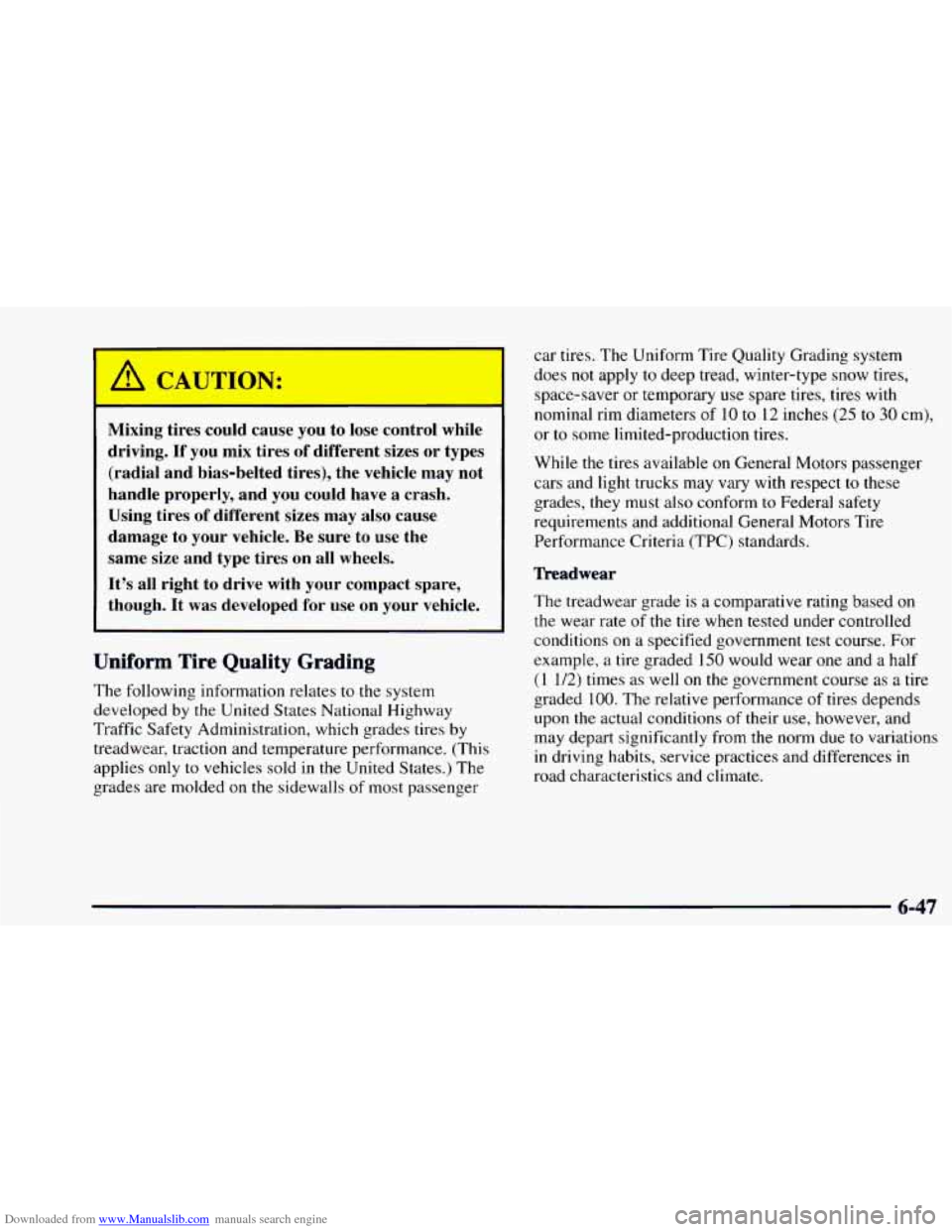
Downloaded from www.Manualslib.com manuals search engine 1 /r CAUTION:
Mixing tires could cause you to lose control while
driving. If you mix tires of different sizes or types
(radial and bias-belted tires), the vehicle
may not
handle properly, and you could have
a crash.
Using tires of different sizes may also cause
damage to your vehicle. Be sure to use the
same size and type tires on
all wheels.
It’s all right to drive with your compact spare, though.
It was developed for use on your vehicle.
Uniform Tire Quality Grading
The following information relates to the system
developed
by the United States National Highway
Traffic Safety Administration, which grades tires by
treadwear, traction and temperature performance. (This
applies only to vehicles sold in
the United States.) The
grades are molded
on the sidewalls of most passenger car
tires. The Uniform Tire Quality Grading system
does
not apply to deep tread, winter-type snow tires,
space-saver
or temporary use spare tires, tires with
nominal rim diameters
of 10 to 12 inches (25 to 30 cm),
or to some limited-production tires.
While the tires available
on General Motors passenger
cars and light trucks may vary with respect to these
grades, they must also conform to Federal safety
requirements and additional General Motors Tire
Performance Criteria (TPC) standards.
Treadwear
The treadwear grade is a comparative rating based on
the wear rate of the tire when tested under controlled
conditions
on a specified government test course. For
example, a tire graded 150 would wear one and a half
(1 1/2) times as well on the government course as a tire
graded
100. The relative performance of tires depends
upon the actual conditions of their use, however, and
may depart significantly from the norm due to variations
in driving habits, service practices and differences in
road characteristics and climate.
6-47
Page 310 of 404
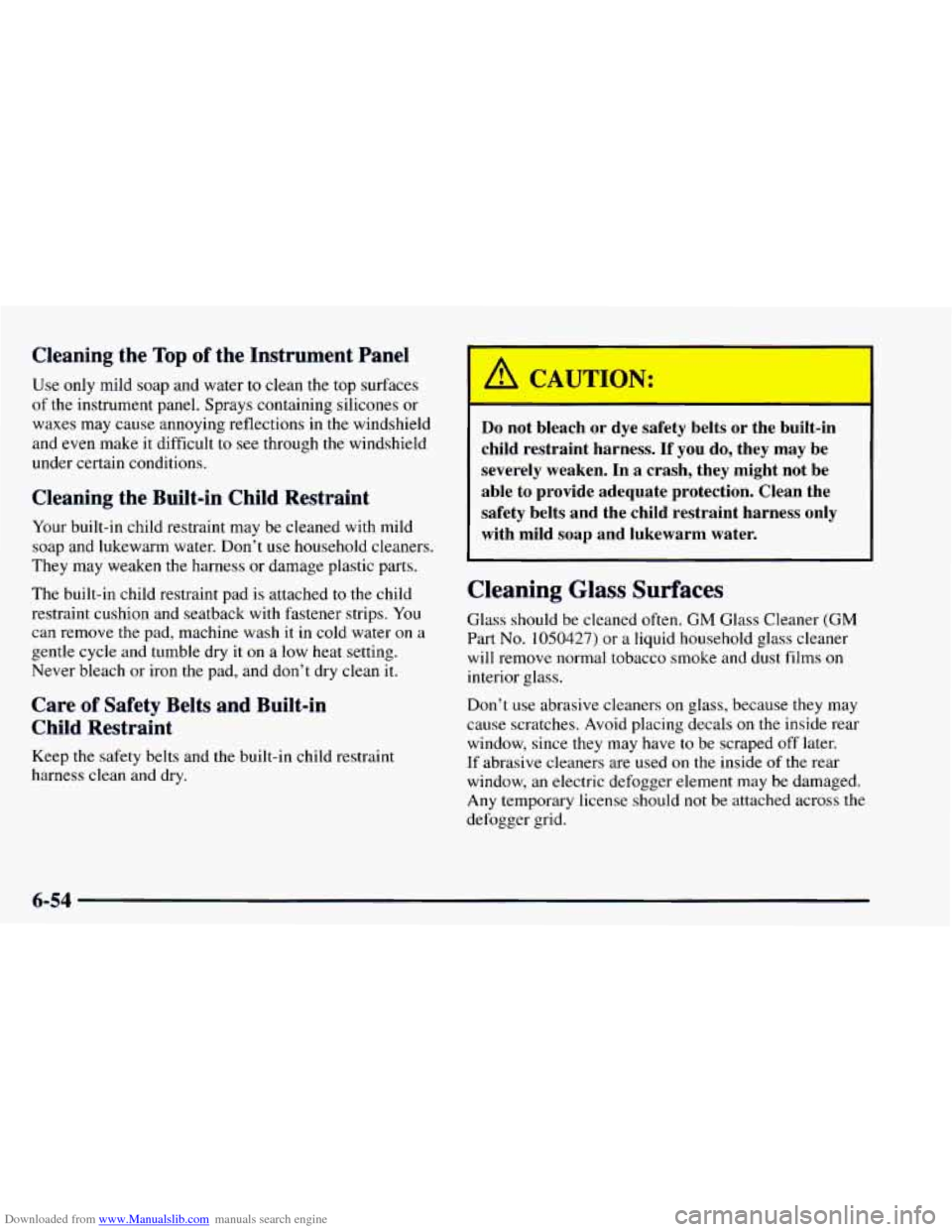
Downloaded from www.Manualslib.com manuals search engine C- -7ing the Top of the Instrument Panel
Use only mild soap and water to clean the top surfaces
of the instrument panel. Sprays containing silicones or
waxes may cause annoying reflections in
the windshield
and even make it difficult
to see through the windshield
under certain conditions.
Cleaning the Built-in Child Restraint
Your built-in child restraint may be cleaned with mild
soap and lukewarm water. Don’t
use household cleaners.
They may weaken the harness or damage plastic parts.
The built-in child restraint pad is attached to the child
restraint cushion and seatback with fastener strips. You
can remove the pad, machine wash it
in cold water on a
gentle cycle and tumble dry it
on a low heat setting.
Never bleach or iron the pad, and don’t dry clean it.
Care of Safety Belts and Built-in
Child Restraint
Keep the safety belts and the built-in child restraint
harness clean and dry.
L
Do not bleach or dye safety belts or the built-in
child restraint harness.
If you do, they may be
severely weaken. In a crash, they might not be
able to provide adequate protection. Clean the
safety belts and the child restraint harness only
with mild soap and lukewarm water.
Cleaning Glass Surfaces
Glass should be cleaned often. GM Glass Cleaner (GM
Part No. 1050427) or a liquid household glass cleaner
will remove normal tobacco smoke and dust films on
interior glass.
Don’t use abrasive cleaners on glass, because
they may
cause scratches. Avoid placing decals on the inside rear
window, since they may have to be scraped off later.
If abrasive cleaners are used on the inside
of the rear
window, an electric defogger element may be damaged.
Any temporary license should not be attached across the
defogger grid.
6-54
Page 329 of 404
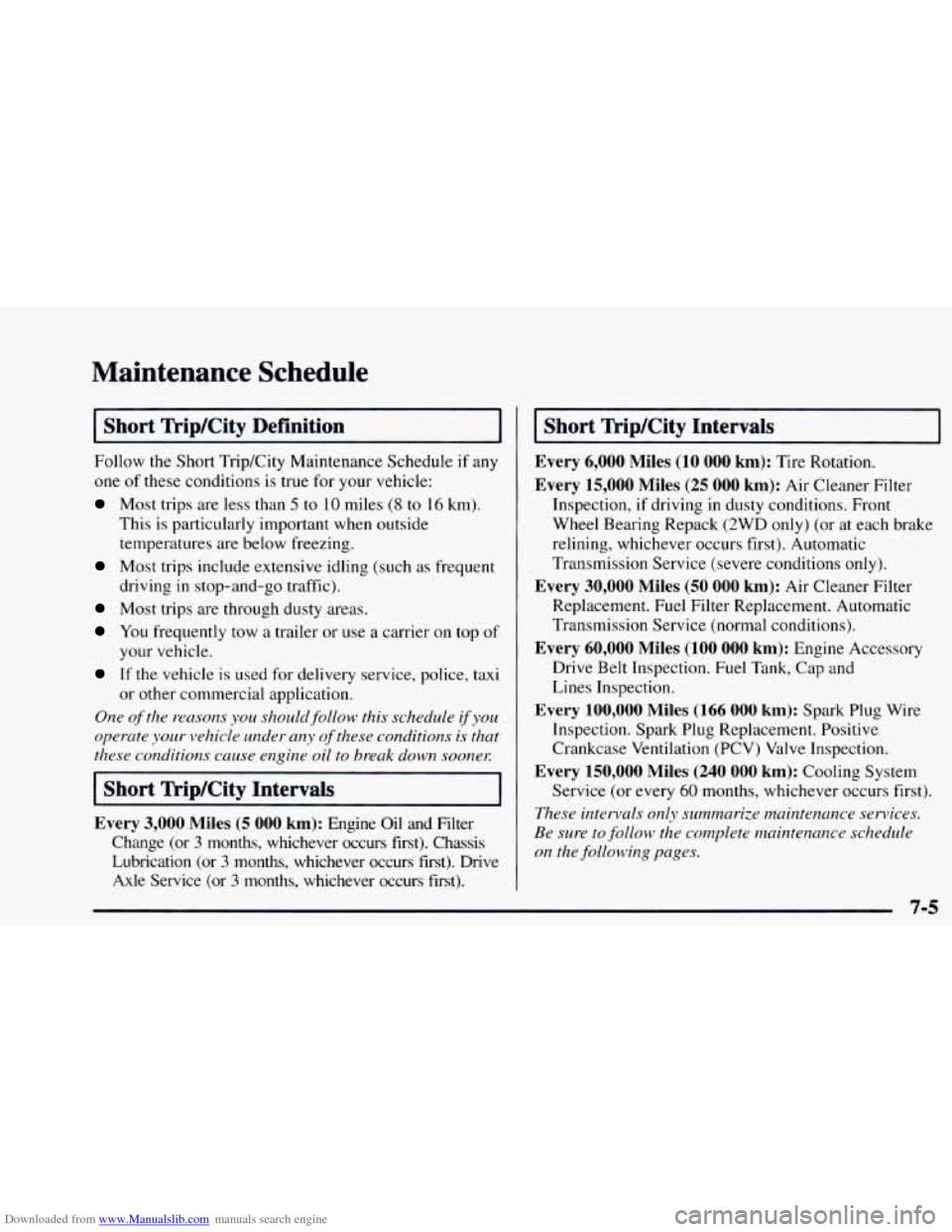
Downloaded from www.Manualslib.com manuals search engine Maintenance Schedule
Short Trip/City Definition
Follow the Short TripKity Maintenance Schedule if any
one of these conditions is true for your vehicle:
Most trips are less than 5 to 10 miles (8 to 16 km).
This is particularly important when outside
temperatures are below freezing.
Most trips include extensive idling (such as frequent
driving in stop-and-go traffic).
Most trips are through dusty areas.
You frequently tow a trailer or use a carrier on top of
If the vehicle is used for delivery service, police, taxi
One of the reasons ~OLI should,follow this schedule ifyou
operate your vehicle under any of these conditions is thnt
these conditions
cause engine oil to brenk down sooneK
your vehicle.
or other commercial application.
I
Short TripKity Intervals
Every 3,000 Miles (5 000 km): Engine Oil and Filter
Change (or
3 months, whichever occurs first). Chassis
Lubrication (or
3 months, whichever occurs first). Drive
Axle Service (or 3 months, whichever occurs first).
Short Trip/City Intervals -
Every 6,000 Miles (10 000 km): Tire Rotation.
Every 15,000 Miles (25 000 km): Air Cleaner Filter
Inspection, if driving in dusty conditions. Front
Wheel Bearing Repack (2WD only) (or at each brake
relining, whichever occurs first). Automatic
Transmission Service (severe conditions
only).
Every 30,000 Miles (50 000 km): Air Cleaner Filter
Replacement.
Fuel Filter Replacement. Automatic
Transmission Service (normal conditions).
Every 60,000 Miles (100 000 km): Engine Accessory
Drive Belt Inspection. Fuel Tank, Cap and
Lines Inspection.
Inspection. Spark Plug Replacement. Positive
Crankcase Ventilation (PCV) Valve Inspection.
Every 150,000 Miles (240 000 km): Cooling System
Service (or every
60 months, whichever occurs first).
These intervnls only sunznznrize muintenance services.
Be sure to follow the comnplete rnainterzance schedule
on the followkg pages.
Every 100,000 Miles (166 000 km): Spark Plug Wire
7-5
Page 330 of 404
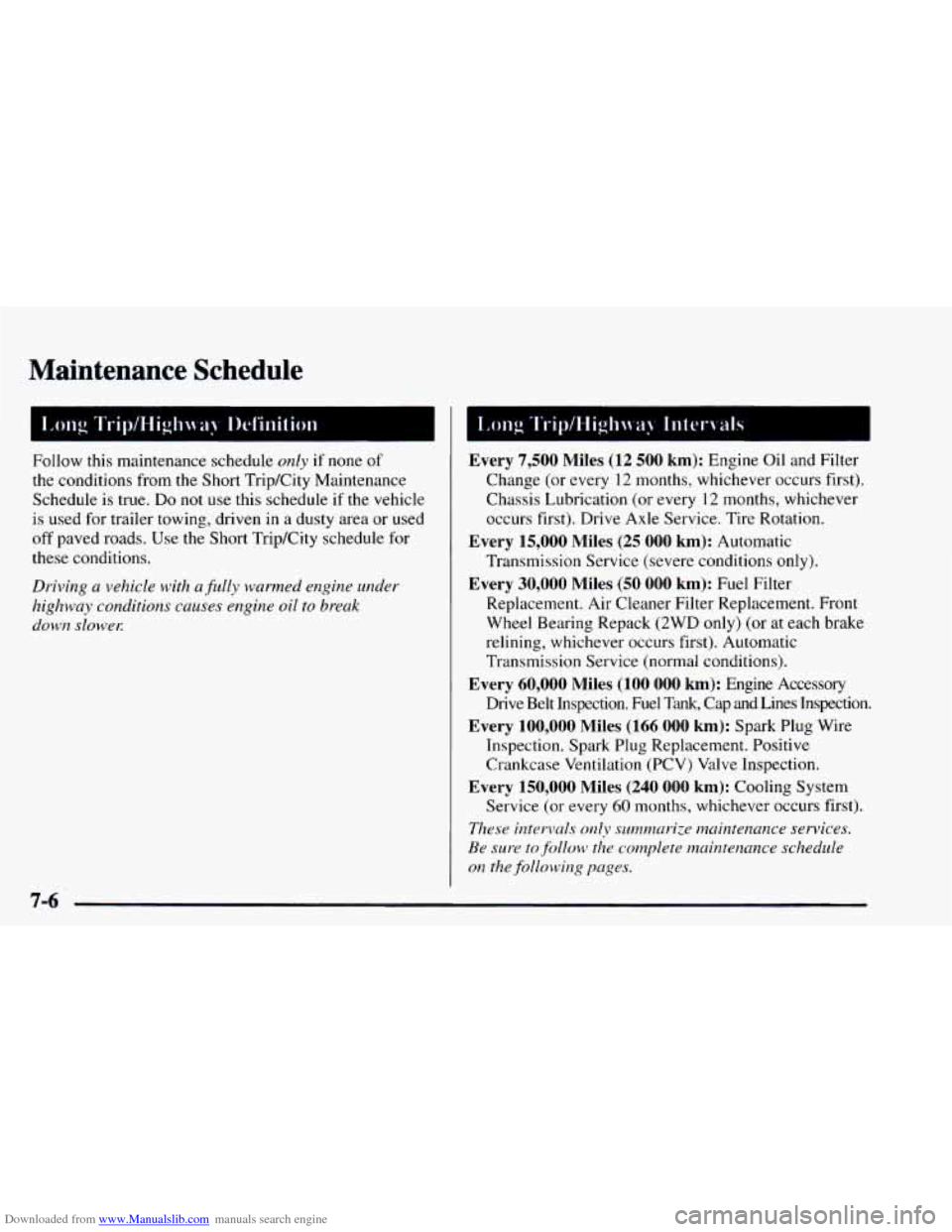
Downloaded from www.Manualslib.com manuals search engine Maintenance Schedule
Follow this maintenance schedule only if none of
the conditions from the Short TripKity Maintenance
Schedule is true.
Do not use this schedule if the vehicle
is used for trailer towing, driven in a dusty area or used
off paved roads. Use the Short TripKity schedule for
these conditions.
Driving a vehicle with a fully warmed engine under
highway conditions causes engine oil to break
down slower:
Every 7,500 Miles (12 500 km): Engine Oil and Filter
Change (or every
I2 months, whichever occurs first).
Chassis Lubrication (or every
12 months, whichever
occurs first). Drive Axle Service. Tire Rotation.
Transmission Service (severe conditions
only).
Replacement. Air Cleaner Filter Replacement. Front
Wheel Bearing Repack
(2WD only) (or at each brake
relining, whichever occurs first). Automatic
Transmission Service (normal conditions).
Drive Belt Inspection. Fuel Tank, Cap and Lines Inspection.
Inspection. Spark Plug Replacement. Positive
Crankcase Ventilation (PCV) Valve Inspection.
Every 150,000 Miles (240 000 km): Cooling System
Service (or every
60 months, whichever occurs first).
These intervals only summarize rncrintenance services.
Be sure
to follow the complete maintenance schedule
on the following pages.
Every 15,000 Miles (25 000 km): Automatic
Every 30,000 Miles (50 000 km): Fuel Filter
Every 60,000 Miles (100 000 km): Engine Accessory
Every 100,000 Miles (166 000 km): Spark Plug Wire
7-6
Page 344 of 404
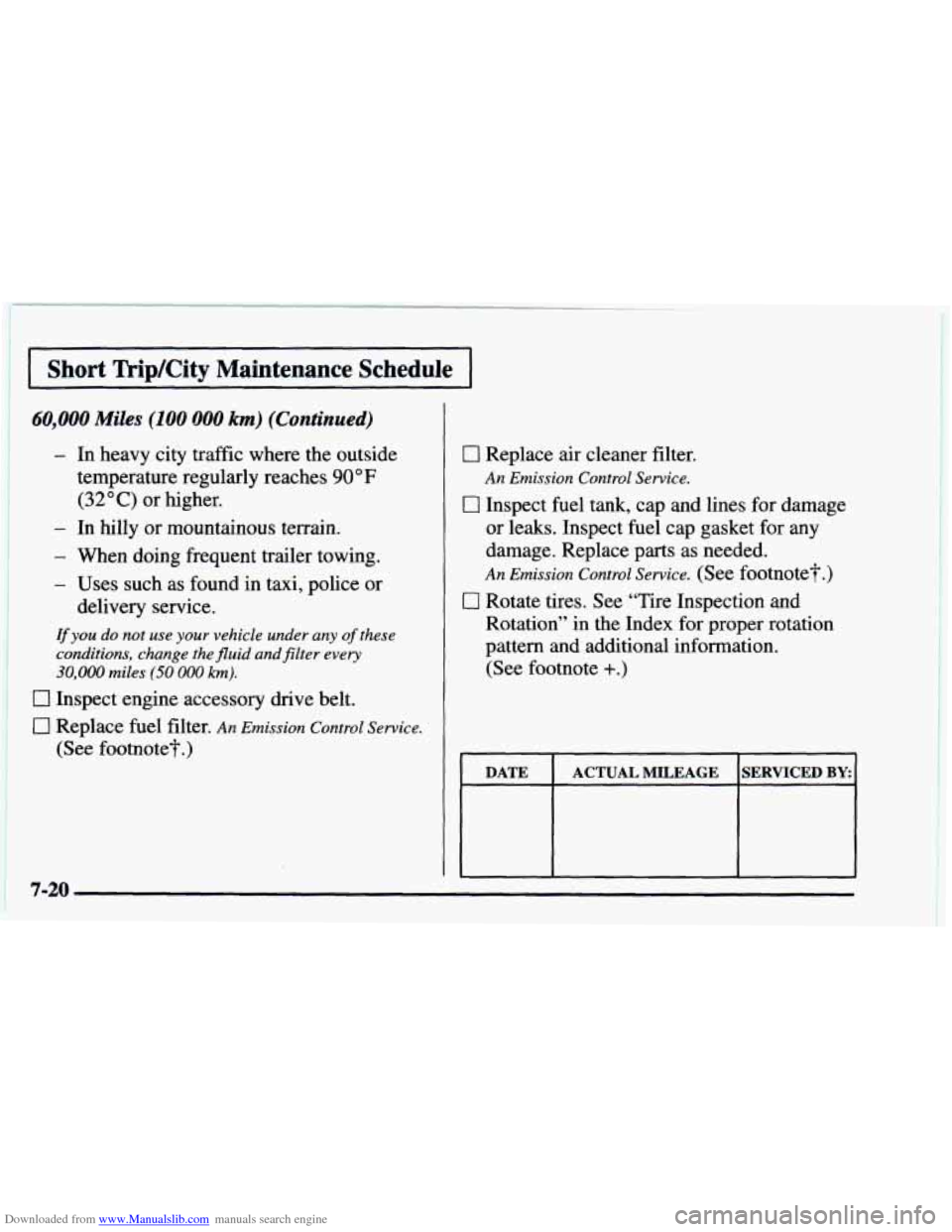
Downloaded from www.Manualslib.com manuals search engine I
I Short Trip/City Maintenance Schedule I
40,000 Miles (100 000 km) (Continued)
- In heavy city traffic where the outside
temperature regularly reaches
90 OF
(32°C) or higher.
- In hilly or mountainous terrain.
- When doing frequent trailer towing.
- Uses such as found in taxi, police or
delivery service.
If you do not use your vehicle under any of these
conditions, change the$uid
and filter every
30,000 miles (50 000 km).
El Inspect engine accessory drive belt.
0 Replace fuel filter. An Emission Control Service.
(See footnote?.)
0 Replace air cleaner filter.
0 Inspect fuel tank, cap and lines for damage
or leaks. Inspect fuel cap gasket for any
damage. Replace
parts as needed.
An Emission Control Service. (See footnote?.)
0 Rotate tires. See “Tire Inspection and
Rotation’’ in the Index for proper rotation
pattern and additional information.
(See footnote
+.)
An Emission Control Service.
DATE ACTUAL MILEAGE
SERVICED BY
7-20
Page 361 of 404
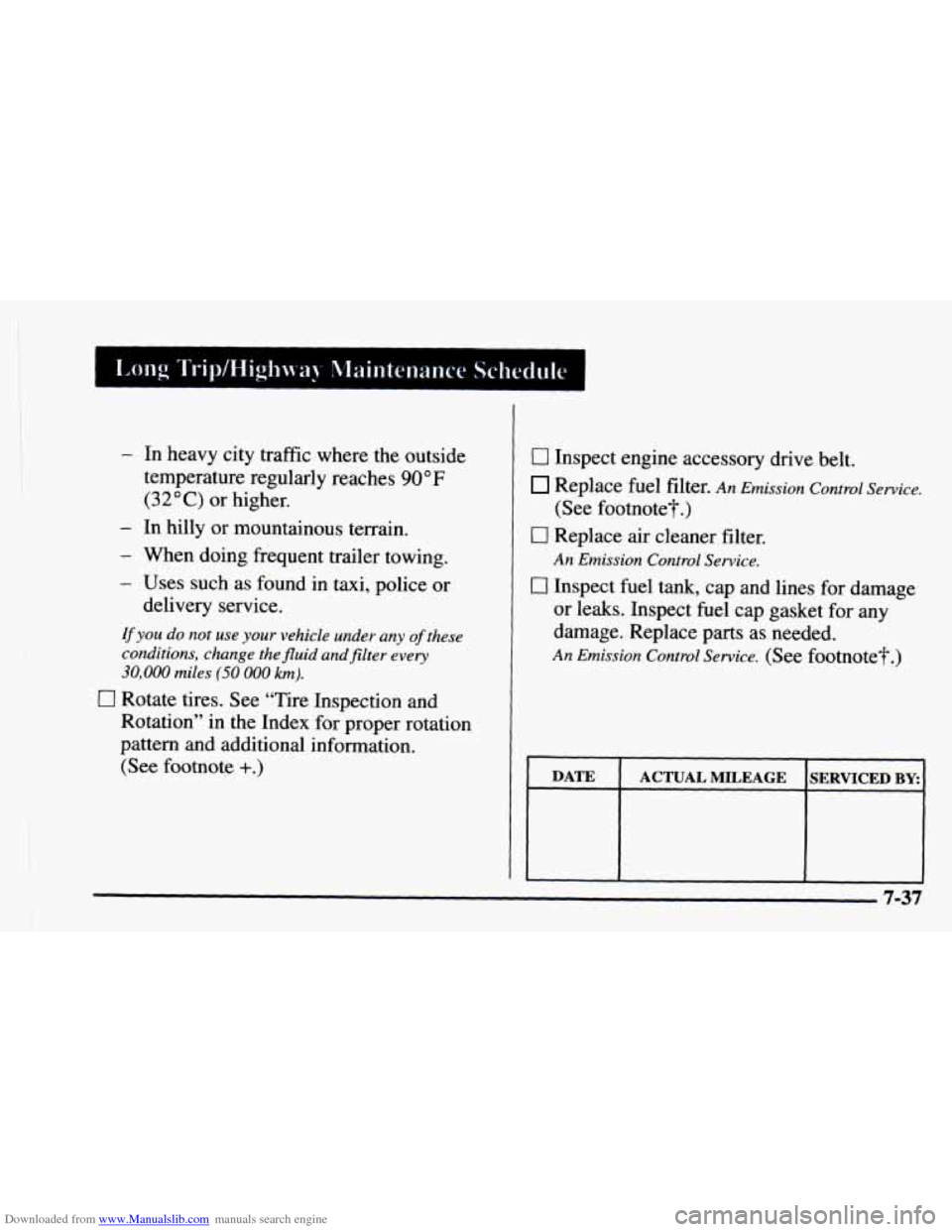
Downloaded from www.Manualslib.com manuals search engine - In heavy city traffic where the outside
temperature regularly reaches
90 OF
(32°C) or higher.
- In hilly or mountainous terrain.
- When doing frequent trailer towing.
- Uses such as found in taxi, police or
delivery service.
If you do not use your vehicle under any of these
conditions, change the fluid and
filter every
30,000 miles (50 000 km).
0 Rotate tires. See “Tire Inspection and
Rotation” in the Index for proper rotation
pattern and additional information. (See footnote
+.)
0 Inspect engine accessory drive belt.
Replace fuel filter. An Emission Control Service.
0 Replace air cleaner filter.
13 Inspect fuel tank, cap and lines for damage
or leaks. Inspect fuel cap gasket for any
damage. Replace parts as needed.
An Emission Control Service. (See footnote?.)
(See footnote?.)
An Emission Control
Service.
7-37
Page 368 of 404

Downloaded from www.Manualslib.com manuals search engine At Least %ice a Year Automatic Transmission Check
Restraint System Check
Make sure the safety belt reminder light and all your
belts, buckles, latch plates, retractors and anchorages are
working properly. If your vehicle has a built-in child
restraint, also periodically make sure the harness straps,
latch plates, buckle, clip, retractors and anchorages are
working properly. Look for
any other loose or damaged
safety belt and built-in child restraint system parts. If
you see anything that might keep a safety belt or built-in
child restraint system from doing its job, have it
repaired. Have any
torn or frayed safety belts or harness
straps replaced.
Also look for any opened or broken air bag covers, and
have them repaired or replaced. (The air bag system
does not need regular maintenance.)
Wiper Blade Check
Inspect wiper blades for wear or cracking. Replace blade
inserts that appear worn
or damaged or that streak or
miss areas of the windshield. Also see “Wiper Blades,
Cleaning” in the Index. Check
the transmission fluid
level; add if needed. See
“Automatic Transmission’’ in the Index.
A fluid loss
may indicate a problem. Check the system and repair
if needed.
At Least Once a Year
Key Lock Cylinders Service
Lubricate the key lock cylinders with the lubricant
specified in
Part D.
Body Lubrication Service
Lubricate all body door hinges, the body hood, fuel
door and rear compartment hinges, latches and locks
including interior glove box and console doors, and any
moving seat hardware. Lubricate the hood safety lever
pivot and prop rod pivot.
Part D tells you what to use.
More frequent lubrication may be required when
exposed to
a corrosive environment.
7-44
Page 395 of 404

Downloaded from www.Manualslib.com manuals search engine Hearing Impaired. Customer Assistance .............. 8-4
Heating
........................................ 3-6
High-Beam Headlamps
.......................... 2-32
Highway Hypnosis
.............................. 4-2 1
Hill and Mountain Roads ......................... 4-22
Hitches. Trailer
................................. 4-34
Hood Checking Things Under
......................... 6-7
Prop
....................................... 6-10
Release
...................................... 6-8
Horn
......................................... 2-31
Hydroplaning
.................................. 4-17
Ignition Positions
.............................. 2. I 5
Ignition Transmission Lock Check ................. 7-46
Inflation. Tire
.................................. 6-44
Inspections
.................................... 7-47
Brakesystem
................................ 7-48
Drive Axle
.................................. 7-48
Exhaust Systems
............................. 7-47
Radiator and Heater Hose
...................... 7-47
Steering
.................................... 7-47
Suspension
.................................. 7-47
Throttle Linkage
.............................. 7-47
InstrumentPanel
............................... 2-56
Brightness Control
............................ 2-39
Cleaning
.................................... 6-54
Cluster
..................................... 2-58
FuseBlock
.................................. 6-62
Interior Lamps
.................................. 2-39
Inside
Daymight Rearview Mirror
................. 2-41 Jack.
Tire
.................................... 5-24
Jump Starting ................................... 5-3
Keyless Entry System
........................... 2-7
Key Lock Cylinders Service
...................... 7-44
Keys
.......................................... 2-2
Labels CertificationlTire
............................. 4-28
Service Parts Identification
..................... 6-60
Tire-Loading information
...................... 4-28
Vehicle Identification Number
................... 6-60
Lamps
........................................ 2-37
Courtesy
.................................... 2-39
Dome
...................................... 2-39
Interior
..................................... 2-39
On Reminder
................................ 2-38
Latches, Seatback
................................ 1-5
Leaving Your Vehicle ............................. 2-7
Leaving Your Vehicle
with the Engine Running ....... 2-25
Lighter
....................................... 2-50
Lights
Air
Bag Readiness ....................... 1-28, 2-61
Anti-Lock Brake System Warning
............ 2-64, 4-7
Brake System Warning
......................... 2-63
Charging System
............................. 2-61
CheckGages
................................ 2-68
Safety Belt Reminder
..................... 1 - 13, 2-60
Service Engine Soon
.......................... 2-65
Daytime Running Lamps Indicator
............... 2-68
9-5